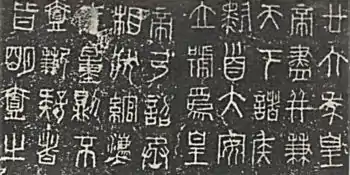| Small seal script | |
|---|---|
 | |
| Script type | |
Time period | Bronze Age China |
| Languages | Old Chinese |
| Related scripts | |
Parent systems | (Proto-writing)
|
Child systems | Clerical script (lishu) Kaishu Traditional Chinese Simplified Chinese Kanji Kana Hanja Zhuyin Chu Nom Khitan script Jurchen script Tangut script |
The small seal script (Chinese: 小篆; pinyin: xiǎozhuàn), or Qin script (秦篆, Qínzhuàn), is an archaic form of Chinese calligraphy. It was standardized and promulgated as a national standard by the government of Qin Shi Huang, founder of the Chinese Qin dynasty.
Name
Xiaozhuan, formerly romanized as Hsiao-chuan, is also known as the seal script or lesser seal script.
History
Before the Qin conquest of the six other major warring states of Zhou China, local styles of characters had evolved independently of one another for centuries, producing "Scripts of the Six States" (六國文字), all of which were included under the general term "great seal script."[1]
However, under one unified government, the diversity was deemed undesirable as it hindered timely communication, trade, taxation, and transportation, and as independent scripts might be used to represent dissenting political ideas.[2]
Hence, Emperor Qin Shi Huang mandated the systematic unification of weights, measures, currencies, etc., and the use of a standard writing script. Characters which were different from those found in Qin were discarded, and Qin's small seal characters became the standard for all regions within the empire. This policy became effective in around 220 BC, the year after Qin's unification of the Chinese states.[3]
Standardization
The standardized use of small seal characters was promulgated via the Cangjiepian, a primer compiled by Qin Shi Huang's ministers. This compilation, stated to contain 3,300 characters, is no longer extant, and is known only through Chinese commentaries over the centuries. Several hundred characters from fragmented commentaries were collected during the Qing period, and recent archeological excavations in Anhui, China, have uncovered several hundred more on bamboo strips, showing the order of the characters. However, the script found was not the small seal script, as the discovery dates back to the Han period.
Unicode
The small seal script has been proposed for inclusion in Unicode. The 723-page proposal from 2015 lists much of the then-known examples of Qing dynasty commentary images.[4] This topic remains under discussion by Unicode's working group as of April 2020.
See also
References
- ↑ "Categories of Calligraphy - Seal Script". www.cityu.edu.hk. Retrieved 2023-09-28.
- ↑ Galambos, Imre (2004). "The Myth of the Qin Unification of Writing in Han Sources". Acta Orientalia Academiae Scientiarum Hungaricae. 57 (2): 181–203. ISSN 0001-6446.
- ↑ Diringer, David. [1982] (1982). The Book Before Printing: Ancient, Medieval, and Oriental. Courier Dover Publications. ISBN 0-486-24243-9.
- ↑ "L2/15-281: Proposal to encode Small Seal Script in UCS" (PDF). Working Group Document, ISO/IEC JTC1/SC2/WG2 and UTC. 2015-10-20. Retrieved 2016-01-23.
External links
- Topical Document List: Seal Script, Unicode
- Lookup of seal script is available through some online dictionaries. See the KU libraries guide for examples.